全文HTML
--> --> -->核级石墨是HTR-PM示范工程所采用的一种关键堆用材料. 核级石墨是化学纯度高、各向异性度低、石墨化程度(即具有完美晶体结构的石墨所占的比例)高的石墨. 核级石墨由于与核燃料和金属材料的相容性较好, 可作为燃料元件基体材料; 机械强度好, 热稳定性强, 适合作为堆内的结构材料; 碳元素核性能优异, 中子慢化能力强, 中子吸收截面小, 因而可作为中子慢化剂和中子反射层材料; 热容量大, 热惯性大, 为事故条件下实行校正措施提供了更充足的时间, 提升了HTR-PM安全性[1—3].
作为HTR-PM示范工程的关键材料, 核级石墨的性能直接影响反应堆的安全运行. 反应堆堆内环境是高温、强中子辐照的环境, 中子辐照对材料造成损伤, 同时, 气冷堆一回路冷却剂气体中含有的氧化性杂质可与石墨发生氧化反应. 辐照和氧化的共同作用导致石墨结构的改变和性能的劣化, 因此研究核级石墨缺陷演化行为受辐照和氧化的影响对于反应堆安全具有重要意义.
对核级石墨辐照行为和氧化行为的研究, 国内外取得了一些进展. 在辐照方面, 通过以往石墨堆运行经验的积累, 中子辐照引起石墨的结构性能变化已经有了比较全面的研究结果[4,5]. 在辐照损伤程度以及石墨抗辐照性能的评价方面, Zhai等[6]和Zeng等[7]系统研究了石墨的拉曼光谱受重离子辐照的影响, 付晓刚等[8]提出石墨气孔形貌变化可作为石墨辐照性能的评价方法, Burchell等[9]提出电阻率可作为研究石墨在辐照和退火后的缺陷演化的指标. 尽管辐照损伤的机理基本确认为辐照产生的点缺陷(间隙原子和空位), 结构性能的变化源自点缺陷的移动、聚合、复合等演化行为[10], 对石墨中缺陷的模型也有一些讨论[11], 但对原子尺度上石墨缺陷演化的研究还不充分.
在氧化方面, 核级石墨孔隙结构[12]和化学成分[13]的复杂性对氧化行为有很大的影响, 使得不同牌号石墨的氧化行为有所差别. 对于气体流速[14]及温度[15,16]等影响石墨氧化的外部因素, 在实验和模拟上已有很多研究. 王鹏和于溯源[17]总结了核级石墨氧化的化学动力学模型、失重率影响因子模型以及模拟计算模型, 建立了一种综合考虑这些因素的影响的石墨氧化模型. 在各种事故条件下的氧化行为也得到了关注和研究, 如郑艳华和石磊[18]、徐伟等[19]研究了不同事故下燃料元件基体石墨的腐蚀对反应堆安全的影响.
反应堆的堆内环境是中子辐照和氧化同时发生的环境, 二者对石墨性能的协同作用还尚未定论. 如Richards等[20]测试了H-451石墨在堆内的水蒸汽腐蚀, 发现水蒸气的辐照裂解和中子对石墨结构造成的破坏增强了石墨的腐蚀. Liu等[21]计算模拟了氧气在核级石墨表面和缺陷点位的吸附, 认为辐照产生的缺陷促进氧的吸附和氧化反应. 而Vavilin和Chernikov[22]用中子辐照过的ZOPG石墨进行研究, 观察到辐照过的样品的腐蚀速率约为未辐照样品的一半. 因而, 为了更准确地预测核级石墨在反应堆内的行为, 有必要对辐照和氧化二者共同作用下核级石墨中缺陷的演化进行深入研究.
由于中子辐照耗时太长、费用昂贵, 且辐照后的样品被中子活化产生放射性, 难以进行后续处理和表征, 因而本文使用离子辐照来实现不同程度的辐照损伤. 本文设计不同的离子辐照和氧化实验, 结合多种表征手段, 揭示其对石墨中点缺陷演化的影响规律.
2
2.1.离子辐照和氧化条件
选择He+离子进行离子辐照. He具有很好的化学惰性, 不会与石墨产生反应, 造成辐照损伤之外的其他破坏. 离子辐照实验在BNU-400 kV离子注入机上进行. 离子辐照使用He+离子能量为190 keV. 由SRIM2008软件[23]模拟的结果(如图1所示)可知, 190 keV的He+在IG-110石墨中造成最大辐照损伤的深度约为表面以下950 nm处, 造成辐照损伤的深度不超过1200 nm. 辐照在室温下进行, 采用注量1 × 1015, 5 × 1015, 1 × 1016和1 × 1017 cm–2模拟不同程度的辐照损伤. 辐照损伤的程度由原子平均离位(dpa)表示, 经计算上述4个注量造成的辐照损伤分别为0.029, 0.14, 0.29和2.9 dpa.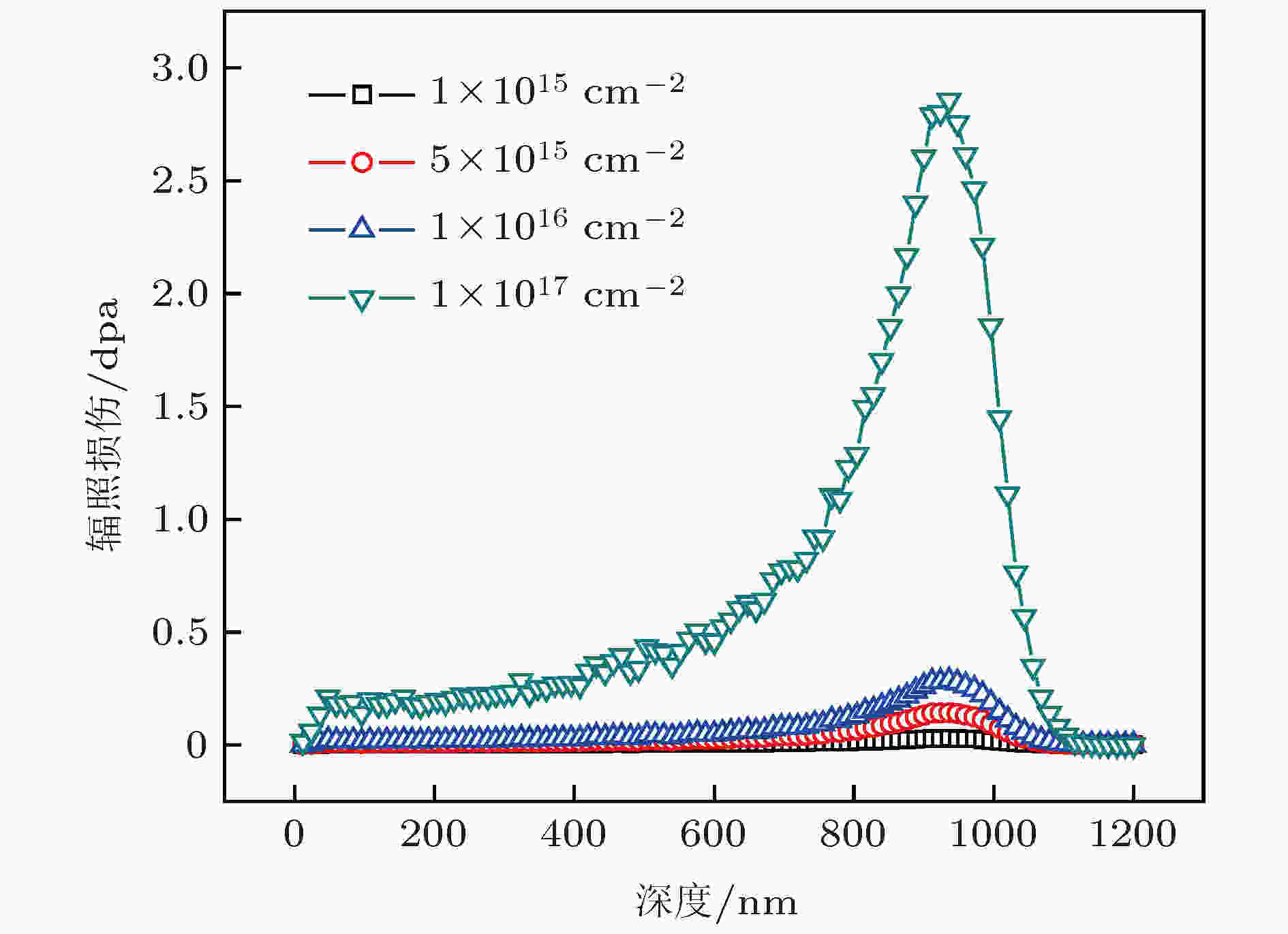 图 1 SRIM软件模拟不同注量的190 keV He+辐照后IG-110核级石墨中缺陷数量的深度分布
图 1 SRIM软件模拟不同注量的190 keV He+辐照后IG-110核级石墨中缺陷数量的深度分布Figure1. SRIM simulation of the depth profiling of defects in IG-110 nuclear grade graphite after different fluences of 190 keV He+ irradiation.
氧化实验采用的氧化气体为20%的O2和80%的He的混合气体, 模拟大气中的氧气浓度. 氧化温度为850 ℃, 氧化时间为10, 15, 20和25 min. 本文选择850 ℃为氧化温度, 此时氧化速率较高, 反应受边界层控制机制支配, 氧气不能扩散深入石墨, 因而氧化只发生在石墨最表面, 内部的石墨处于高温环境中, 点缺陷的行为主要受氧化时伴随的高温的影响[16,24].
在辐照后氧化和氧化后辐照的实验中, 为了分别研究辐照剂量和氧化时间对石墨中的缺陷的影响, 分别对辐照和氧化的条件进行控制. 辐照后氧化的实验可分为两组: 一组是先进行1 × 1017 cm–2 He+辐照, 再分别氧化15和25 min; 另一组是先进行1 × 1015, 5 × 1015, 1 × 1016和1 × 1017 cm–2 He+辐照, 再氧化15 min. 氧化后辐照实验可分为两组: 一组是先氧化15 min, 再进行1 × 1015, 5 × 1015, 1 × 1016和1 × 1017 cm–2 He+辐照; 另一组是先氧化15和25 min, 再进行1 × 1017 cm–2 He+辐照.
2
2.2.表征方法
采用扫描电子显微镜(scanning electron microscopy, SEM)和X射线衍射(X-ray diffraction, XRD)表征样品的表面形貌、孔隙尺寸和晶体结构. SEM是常用的形貌观察手段, 可观察石墨表面的孔隙形状、分布和尺寸. 而XRD衍射可测量石墨晶体各晶面的布拉格衍射峰, 从而判断石墨的晶体结构. SEM观察在JEOL-JSM 7001F型扫描电子显微镜上进行, XRD测试在D/max-2500/PC型多晶X射线衍射仪上进行. 考虑到粒子辐照影响的深度较浅, XRD测试采用小角掠入射X射线衍射.拉曼光谱可用于测量样品的石墨化程度. 石墨的拉曼光谱中显示4个强的拉曼特征峰, 即G峰、D峰以及其二阶散射峰G*峰和D*峰. 在1580 cm–1处的G峰为石墨晶体的E2g光学模, 在1350 cm–1处的D峰为需要缺陷参与的双共振拉曼散射过程[25]. D峰和G峰的强度比ID/IG与缺陷密度有关, 通常认为缺陷密度较小时ID/IG与“缺陷的平均距离”的平方成反比, 与晶粒尺寸(晶粒边缘视作缺陷)成正比, 而缺陷密度较大时ID/IG与“缺陷的平均距离”成正比; 比例系数与拉曼测试的激光波长有关[26]. 因此, 可以由D峰与G峰的强度比(ID/IG)的大小判断石墨化程度的高低和缺陷的数量. 本文采用HORIBA Jobin Yvon HR800拉曼光谱仪测量石墨的拉曼光谱.
正电子湮灭多普勒展宽(positron annihilation Doppler broadening, PADB)是一种将正电子注入材料表面, 通过测量正电子与材料中的电子湮灭后产生的光子的能量, 从而分析材料中缺陷种类和密度的测试方法. PADB测试已被证明能够用于有效研究石墨中的缺陷[27,28]. 正电子与静止电子湮灭释放出的光子的能量为511 keV, 但由于材料中的电子具有动量, 受多普勒效应的影响, 释放出的光子能量发生改变, 在能谱图上的峰位产生偏移. 正电子与动量较小的价电子湮灭后, 光子能量的偏移小; 正电子与动量较大的内层电子湮灭后, 光子能量的偏移大. 多普勒展宽的程度可以用S参数和W参数表示[29]. S参数代表能量偏移较小的光子, 即由正电子与动量较小的价电子湮灭释放的那部分光子, 因此S参数对材料中的空位型缺陷敏感. W参数代表能量偏移较大的光子, 即由正电子与动量较大的内层电子湮灭释放的那部分光子. 正电子注入材料的深度与正电子能量和材料密度有关, 统计不同能量的正电子与材料发生湮灭所释放的光子能量, 可知材料缺陷随深度的分布. 本文的PADB测试由可变能量正电子束装置[30]完成, 该装置产生的正电子束的能量可以在0.1—25 keV的范围内调整, 25 keV的正电子在石墨中的平均注入深度为4.17 μm, 涵盖了本工作190 keV的He+离子辐照造成损伤的深度范围.
3.1.辐照和氧化对晶体结构、形貌的影响
仅辐照的样品和仅氧化的样品的XRD图谱如图2所示. 由于2θ = 26.4°左右的石墨(002)衍射峰比其他峰强得多, 所以为了比较大多数衍射峰的峰形, 图2的横坐标2θ从40°开始. 仅辐照(Irr.)的样品的XRD图谱表明, 在本文的离子辐照条件下的剂量不影响石墨的晶体结构. 仅氧化(Ox.)的样品的XRD图谱表明, 石墨的晶体结构也没有因氧化而发生改变.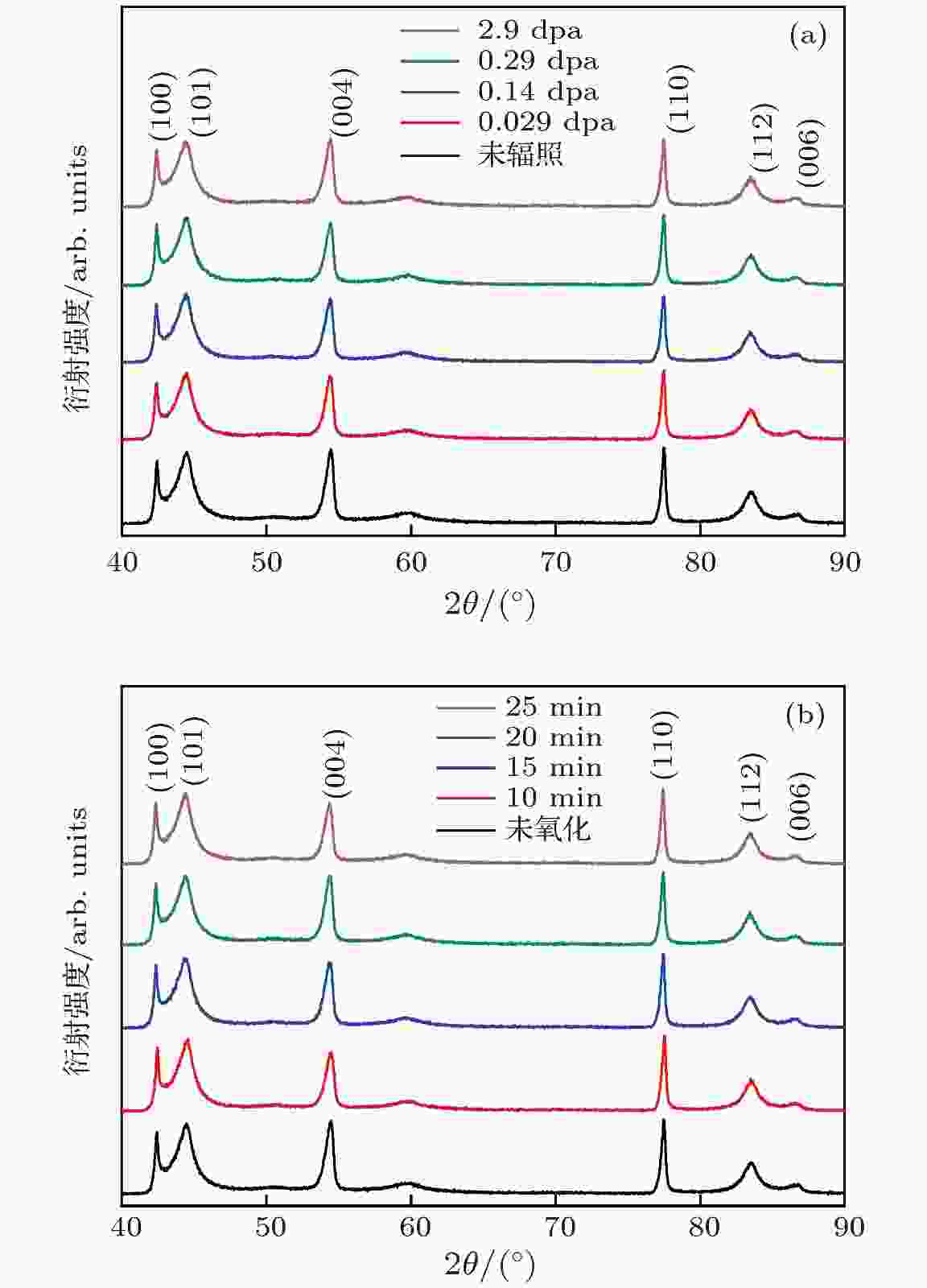 图 2 样品的XRD图谱 (a)仅辐照的样品; (b)仅氧化的样品
图 2 样品的XRD图谱 (a)仅辐照的样品; (b)仅氧化的样品Figure2. XRD patterns of the samples: (a) Irr. samples; (b) Ox. samples
仅氧化的样品的SEM形貌如图3所示. 由图3可见, 氧化后孔径尺寸略微增大. 统计未氧化样品和氧化10, 15, 20和25 min的样品表面孔径, 得到未氧化样品和氧化10, 15, 20和25 min后IG-110核级石墨平均孔径分别为7.5, 8.8, 8.0, 8.1和8.1 μm. 由SEM观察到的孔径变化可以确认, 850 ℃氧化之后IG-110石墨表面孔径比未氧化时略有增大, 而不同时间氧化后IG-110石墨的孔径比较接近, 说明20%的O2在850 ℃温度下与IG-110石墨含有的填充颗粒和粘结剂相组分发生的氧化反应比较均匀, 没有引起孔隙结构的显著变化, 且反应受边界层控制机制的支配, 氧化只发生在表面, 因而氧化后样品形貌与未氧化样品区别较明显, 而氧化不同时间之后的样品形貌区别不明显.
 图 3 样品的尺寸和形貌 (a)未处理样品尺寸; (b)未处理样品的SEM形貌; 氧化(c) 10, (d) 15, (e) 20, (f) 25 min的样品的SEM形貌
图 3 样品的尺寸和形貌 (a)未处理样品尺寸; (b)未处理样品的SEM形貌; 氧化(c) 10, (d) 15, (e) 20, (f) 25 min的样品的SEM形貌Figure3. Size and morphology of the samples: (a) Size of untreated sample; SEM morphology of (b) untreated sample; SEM morphology and of Ox. samples that were oxidized for (c) 10, (d) 15, (e) 20, (f) 25 min.
2
3.2.辐照和氧化对点缺陷和石墨化程度的影响
仅辐照的样品的拉曼光谱和ID/IG的变化如图4(a)和图5(a)所示. 由图4(a)可见, 未辐照样品D峰很弱, 辐照后的样品则出现了明显的D峰, 并且D峰和G峰在高剂量辐照后明显展宽. Zhai等[6]也观察到离子辐照前石墨D峰很微弱, 而辐照后D峰随注量增大而有所增强. Lucchese等[31]认为D峰的展宽代表非晶结构的形成, 但在本工作的XRD测试中没有观察到非晶结构的形成, 可能是由于拉曼光谱比X射线衍射对于石墨非晶结构更敏感.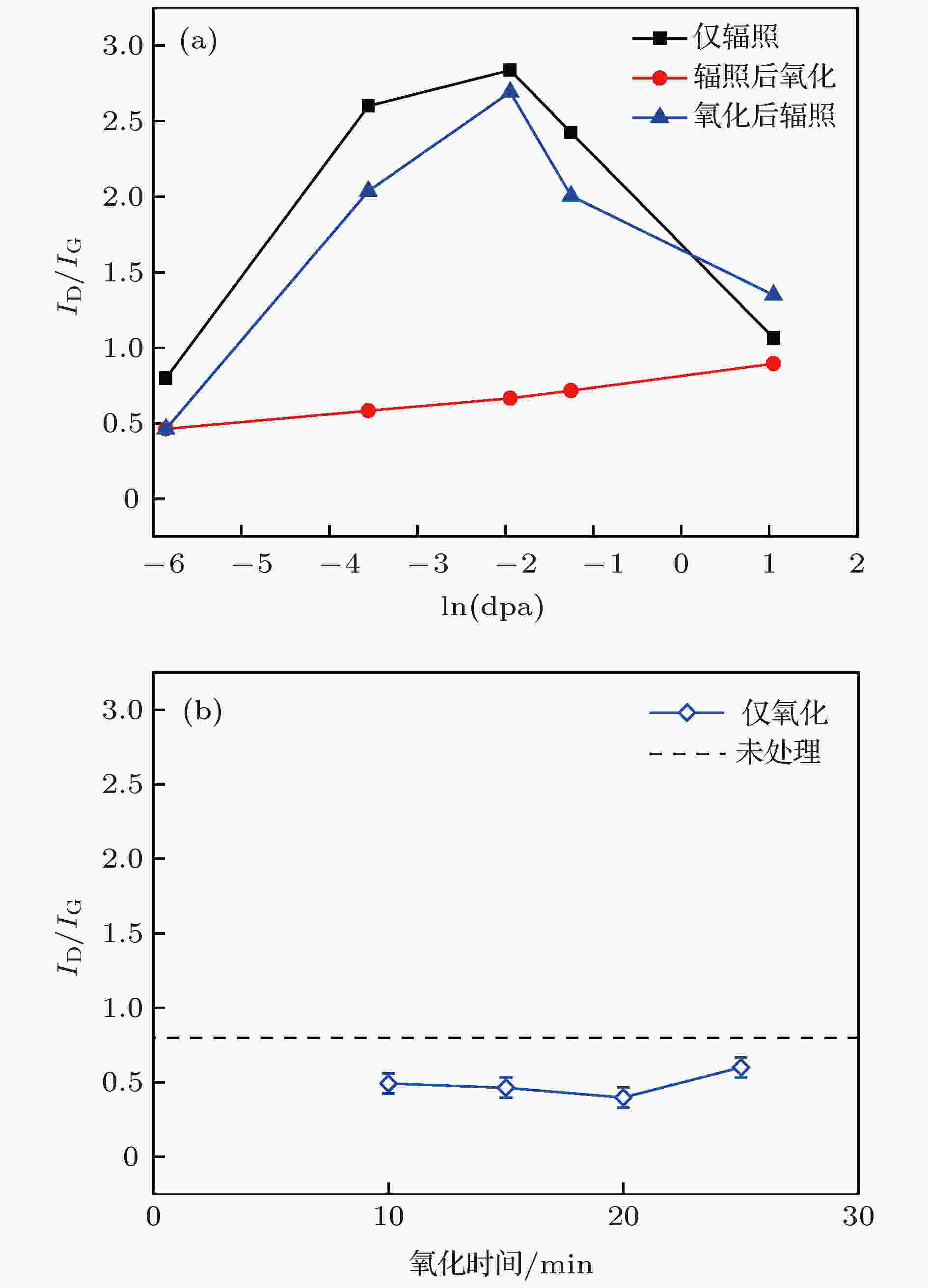 图 5 ID/IG的变化 (a)仅辐照的样品、辐照后氧化的样品和氧化后辐照的样品; (b)仅氧化的样品的ID/IG
图 5 ID/IG的变化 (a)仅辐照的样品、辐照后氧化的样品和氧化后辐照的样品; (b)仅氧化的样品的ID/IGFigure5. Evolution of ID/IG ratios of the samples: (a) Irr., Irr.-Ox., Ox.-Irr. samples; (b) Ox. samples.
图5(a)横坐标为辐照后用SRIM2008模拟计算得到的辐照损伤(dpa)的对数值, 三条折线最左侧的点代表的都是未辐照的样品. 由图5(a)可见, 随着辐照剂量增加, ID/IG高于未处理样品, 且先增大后减小, 点缺陷浓度先增大后降低. 跟据Lucchese等[31]的研究, 围绕但不包括缺陷的环形区域(“活化区域”)对D峰强度的贡献比缺陷区域更大. 在低剂量下, 辐照产生的点缺陷浓度随着辐照剂量增大而增大, 石墨化程度随之降低. 而在高剂量下, “缺陷的平均距离”因为缺陷的增多而减少, 缺陷的影响区域发生重叠, 导致这种“活化区域”反而减少, 因而高剂量下ID/IG随石墨缺陷密度的增高而降低. 另一方面, 由于间隙原子的扩散可以导致原本孤立的间隙原子聚集成了间隙原子链和间隙原子环, 最后形成新的石墨原子层, 而原本孤立的空位也能形成空位簇[32], 这种效应也对高辐照剂量下ID/IG的降低有所贡献.
仅氧化的样品的拉曼光谱和ID/IG的变化如图4(b)和图5(b)所示. 由图4(b)和图5(b)可见, 氧化能够使ID/IG降低到低于未处理样品的水平. 这种现象可归因于氧化时的高温带来的退火效应, 即高温下缺陷容易移动, 点缺陷发生复合并消失[28]. 未处理样品中也存在一定的点缺陷, 因而高温氧化的退火效应使得氧化后石墨点缺陷浓度低于未处理样品. 另外, 该结果也说明, 20%的O2在850 ℃条件下的氧化对石墨的破坏不体现为增加点缺陷.
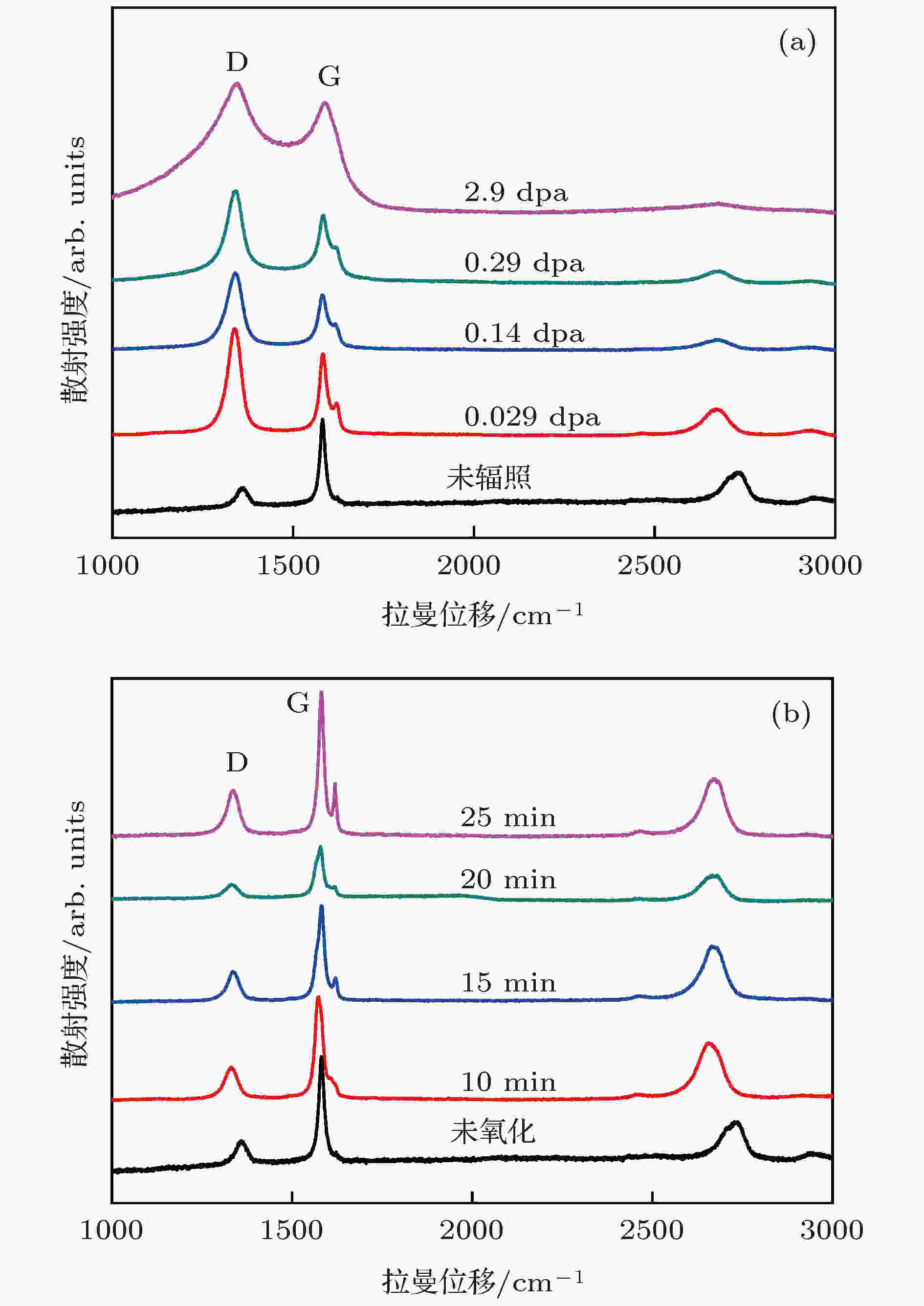 图 4 样品的拉曼光谱 (a)仅辐照的样品; (b)仅氧化的样品
图 4 样品的拉曼光谱 (a)仅辐照的样品; (b)仅氧化的样品Figure4. Raman spectra of the samples: (a) Irr. samples; (b) Ox. samples.
对于进行不同剂量的离子辐照后再氧化相同时间的样品, 由图5(a)可见, ID/IG处于与未处理样品相当的水平, 甚至略低于未处理样品. 这是因为离子辐照产生的点缺陷在高温退火效应影响下发生复合. 注意到图5(a)中辐照后氧化的石墨样品的ID/IG高于仅氧化的样品, 说明850 ℃高温退火效应不能消除所有离子辐照产生的缺陷. 这是因为辐照产生的点缺陷发生移动和聚集, 形成的一些较大的缺陷团簇需要比850 ℃更高的温度才能够回复[11,28].
对于固定氧化时间、氧化后辐照的样品, 由图5(a)可见, 其ID/IG与仅辐照样品的ID/IG变化趋势一致, 即高于未处理样品, 且先增大后减小, 同样表示点缺陷数量的增加以及由此导致的石墨化程度的下降. 结合仅氧化石墨样品与未处理样品的对比可以推测, 首先在高温氧化过程中, 退火效应将点缺陷的数量减少到低于未处理样品的水平. 随后, 辐照在石墨中产生缺陷, 但由于石墨中缺陷的初始浓度低于未处理样品, 因而在相同剂量的辐照之后, 氧化后辐照的样品的ID/IG略小于仅辐照的样品. 而在辐照剂量最高的条件下, 氧化后辐照样品的ID/IG高于仅辐照样品, 可能是由于初始缺陷较少, 因而离子辐照新引入的缺陷造成的“活化区域”在达到最大之后的减少程度反而不如仅辐照样品, ID/IG下降的程度也不如仅辐照的样品.
2
3.3.点缺陷的演化
仅辐照的样品和仅氧化的样品中不同深度的S参数如图6(a)和图6(b)所示. 为了图片显示清楚, 图中仅标出了未处理样品的S参数的误差棒, 其他样品的S参数的误差棒大小与此相近. 由图6(a)可见, 在仅辐照的样品中缺陷数量出现一个缓峰, 其宽度与SRIM预测的缺陷分布相符. 辐照剂量越高, S参数也越高, 即形成了更高浓度的缺陷. 另一方面, 从图6(b)可知氧化之后S参数降低, 可以用高温条件下的退火效应解释. 图6(c)和图6(d)显示了平均S参数(在250—1250 nm的深度范围内计算, 涵盖了缓峰的范围)随辐照剂量和氧化时间的变化, 清楚地显示出辐照会产生缺陷而氧化减少了点缺陷的规律.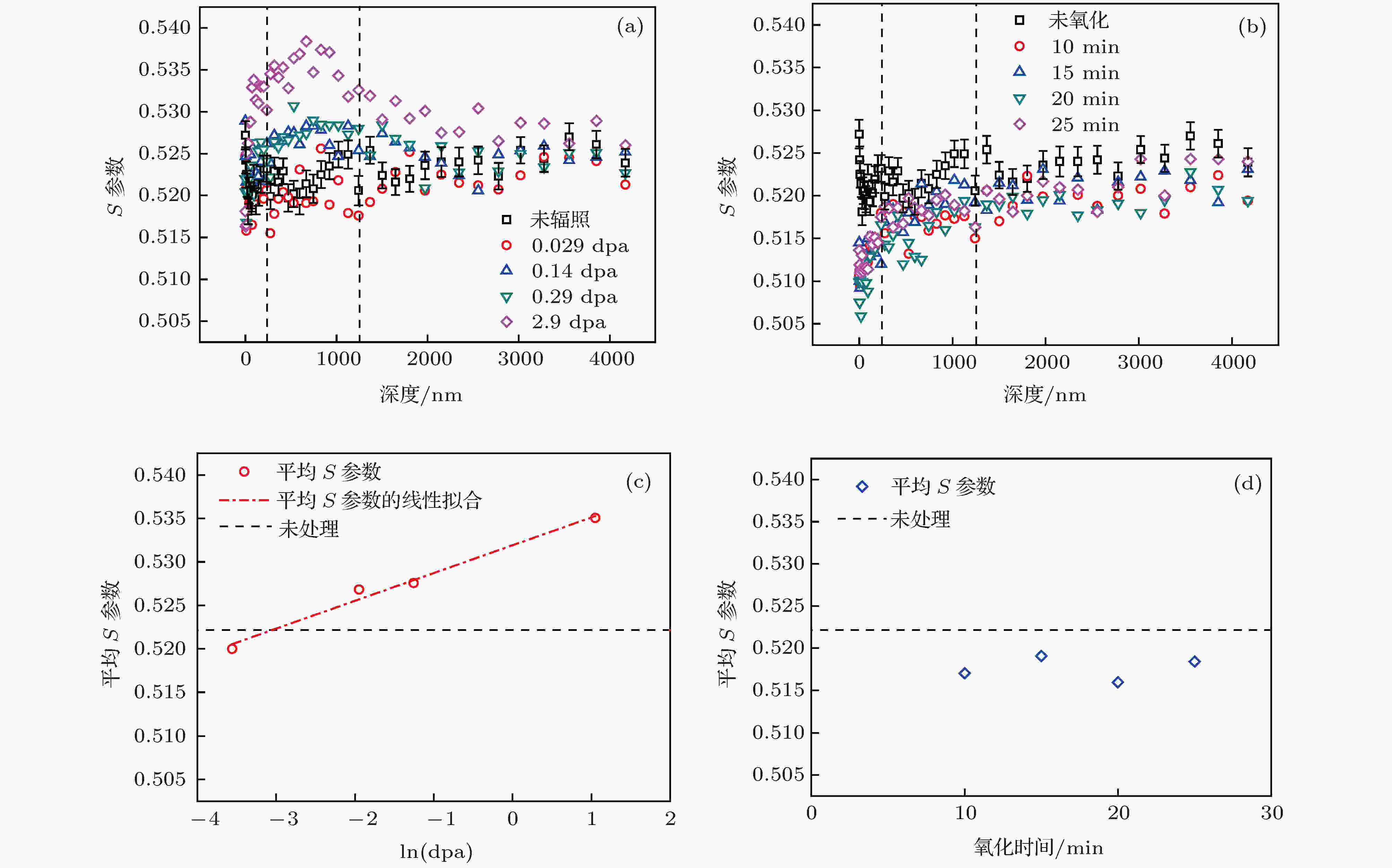 图 6 样品中不同深度的S参数和平均S参数随辐照剂量和氧化时间的变化 (a), (c)仅辐照的样品; (b), (d)仅氧化的样品
图 6 样品中不同深度的S参数和平均S参数随辐照剂量和氧化时间的变化 (a), (c)仅辐照的样品; (b), (d)仅氧化的样品Figure6. Profiles of S-parameter and trends of the evolution of S-parameter: (a), (c) Irr. samples; (b), (d) Ox. samples.
平均S参数和平均W参数之间的关系如图7所示. 第一, 离子辐照和氧化对点缺陷的演化产生相反的影响. 离子辐照使S参数增大, 使W参数减小; 氧化使S参数减小, 使W参数增大. 高辐照剂量样品位于未处理样品的右下方, 仅氧化样品和辐照后氧化样品位于未处理样品的左上方. 第二, 相同辐照剂量的样品的S, W参数比较接近, 在图上分布比较集中, 如黑色圆圈圈出的区域所示, 说明离子辐照产生点缺陷的量是确定的. 第三, 对于所有样品, 平均S参数和平均W参数之间存在较好的线性关系, 随着辐照剂量的增加或氧化时间的增加没有发生转折, 表明在石墨中只存在一种正电子敏感的缺陷类型, 即Frenkel点缺陷的空位(正电子对空位型缺陷敏感, 对间隙原子不敏感)[27,28]. 第四, 点缺陷空位可以聚集成空位簇或多空位复合物, 在更高的温度下才能被去除[9,33]. 因此, 对于辐照后氧化的样品, 退火不能使缺陷完全回复, 其S参数和ID/IG高于仅氧化的样品, 体现在图中即辐照后氧化样品位于仅氧化样品的右下方.
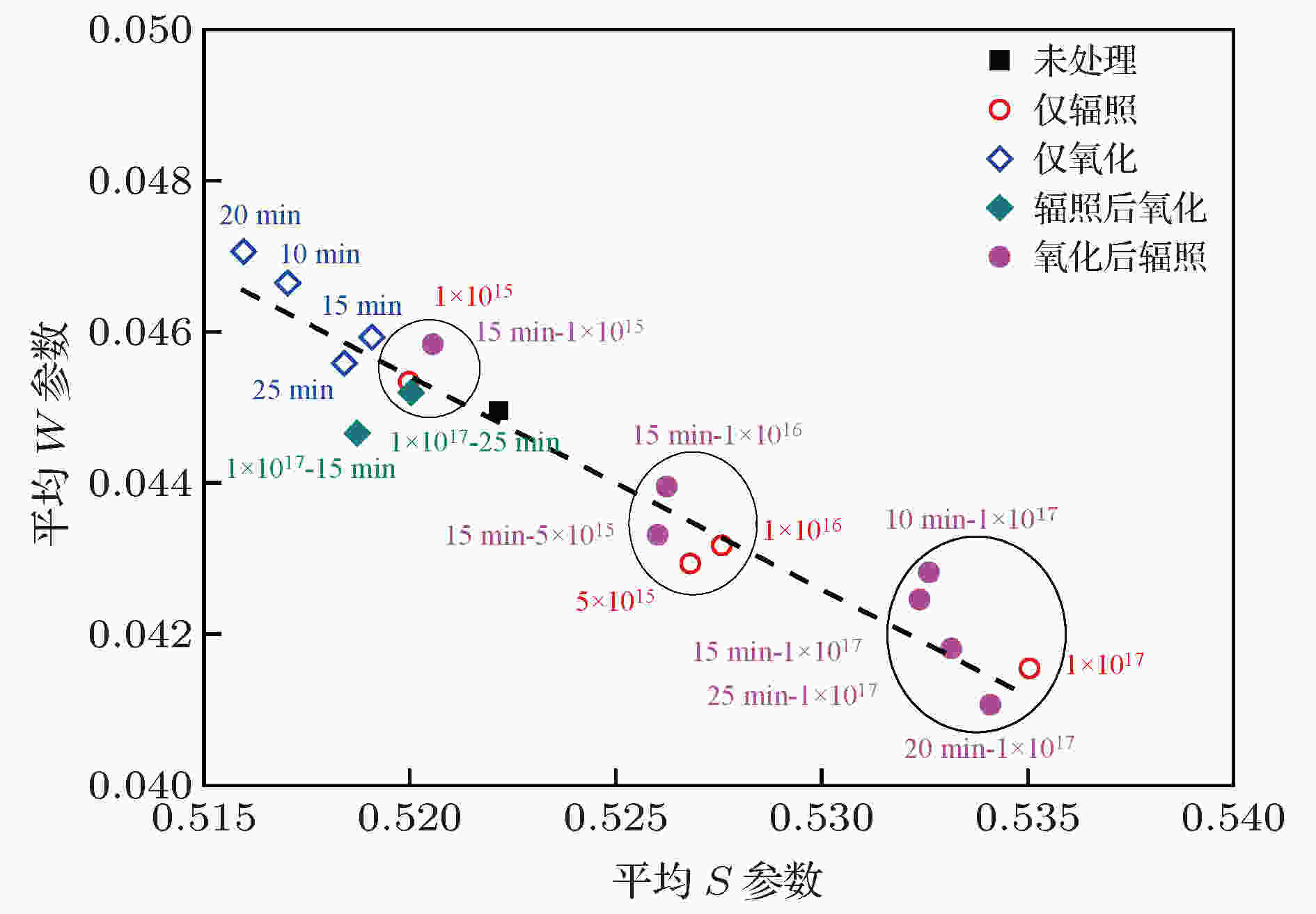 图 7 在250—1250 nm的深度范围内平均S参数和平均W参数之间的关系
图 7 在250—1250 nm的深度范围内平均S参数和平均W参数之间的关系Figure7. Relationship of the average S- and W-parameter in 250?1250 nm of all samples.
